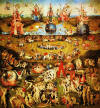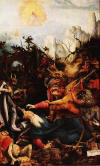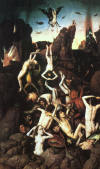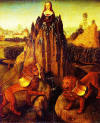Search:: Artists Alphabetically Symbolism 50 Greatest Paintings Art Movements
Examples of post-plague paintings (click to enlarge)
The Consequence of the Great Plague on Art and Artists in the Middle Ages
 When
the plague struck, Europe was emerging from the "dark ages"
trying to put unpleasant memories behind it and move on to a more
free-thinking era. Barbarians no longer ran rough shod,
killing innocent farmers
and townsfolk. Beautiful
cities such as
Siena of Italy were
establishing righteous
republics and
commissioning
secular art.
Without
the constant fear of
invasion and barbarity,
art and architecture
found fertile ground to
grow. Medieval
painters were not simply
anonymous lowly
craftsmen, but well
respected professionals.
They were held in high
esteem and often
interacted with clergy
and wealthy patrons.
The arrival of Black
death harkened in a new
darker era of painting.
Artists were beset
by the constant terror
of death and suffering,
causing them to look for
answers in scripture and
the Church. Many
painters lost their
entire extended family
or half of them at the
very least. It is
difficulty for us to
imagine sitting here
surfing the internet
just what it would be
like to live through
such a horrific tragedy.
To lose all your loved
ones in a matter of
days. Survivors were
often left with oozing
sores that never healed
and patches of missing
hair that would never
grow back, lungs so
damaged that breathing
would be a difficulty
for the remainder of
their life. It is no
wonder that paintings
overflowed with tortured
souls, death, dying,
fire and brimstone.
When
the plague struck, Europe was emerging from the "dark ages"
trying to put unpleasant memories behind it and move on to a more
free-thinking era. Barbarians no longer ran rough shod,
killing innocent farmers
and townsfolk. Beautiful
cities such as
Siena of Italy were
establishing righteous
republics and
commissioning
secular art.
Without
the constant fear of
invasion and barbarity,
art and architecture
found fertile ground to
grow. Medieval
painters were not simply
anonymous lowly
craftsmen, but well
respected professionals.
They were held in high
esteem and often
interacted with clergy
and wealthy patrons.
The arrival of Black
death harkened in a new
darker era of painting.
Artists were beset
by the constant terror
of death and suffering,
causing them to look for
answers in scripture and
the Church. Many
painters lost their
entire extended family
or half of them at the
very least. It is
difficulty for us to
imagine sitting here
surfing the internet
just what it would be
like to live through
such a horrific tragedy.
To lose all your loved
ones in a matter of
days. Survivors were
often left with oozing
sores that never healed
and patches of missing
hair that would never
grow back, lungs so
damaged that breathing
would be a difficulty
for the remainder of
their life. It is no
wonder that paintings
overflowed with tortured
souls, death, dying,
fire and brimstone.
Symptoms include swelling of the lymph nodes, high fevers, large blackish pustules that quickly burst, oozing a foul smelling liquid, aching limbs, and vomiting of blood. In the end the sufferer turned into an unrecognizable, misshapen hobgoblin. They died by the millions, alone in agony, their kinsmen fleeing in terror. Government and Clergy tried to control the catastrophe by instituting quarantines, but the disease progressed relentlessly, eventually killing off a substantial segment of Europe's population. Preventing the Plague Many believed that the disease was spread upon the air, So, the survivors turned to incense, flowers, fragrant oils and perfumes to ward off the deadly vapors that they believed to be causing the contamination. With so many bodies piling up, if nothing else the air smelled a bit better. It is a myth that people did not bathe in the Middle Ages, there were communal baths in almost every village. They did not bathe every day but most bathed weekly during the warmer months. People began airing out their linens and burning bedding used by the victims. This probably helped to staunch the death tide in a small way. Towns rang church bells, fired cannons and held parades where all the citizens paraded through the streets banging pots and pans to drive the plague away. Gypsies, heretics, foreign travelers, dwarfs and lepers were rounded up and put into wooden buildings and roasted alive as they were believed to be the carriers of the disease. Medieval entrepreneurs made a fortune selling talismans, lucky charms and enchantments. Peasants who could not afford such luxuries simply wore a necklace of garlic around their necks or crushed herbs in their pockets. Some people believed that is you cut off a finger or toe the disease would spare you. Fingers and toes were lopped off by the thousands. People were frantic for a remedy and would try anything, no matter how peculiar or bizarre. Life in the Middle Ages In the Medieval period, people concentrated mainly on the church, God, and personal salvation. Life in Medieval Europe was primitive and far more difficult than that of Imperial Rome. The Average life expectancy was only 30. Christianity provided an ethical element lacking in previous cultures.

A song about the Plague from the Middle Ages
"A
sickly season," the
merchant said,
"The town I left was
filled with dead,
and everywhere these
queer red flies
crawled upon the
corpses' eyes,
eating them away."
"Fair make you sick,"
the merchant said,
"They crawled upon the
wine and bread.
Pale priests with oil
and books,
bulging eyes and crazy
looks,
dropping like the
flies."
"I had to laugh," the
merchant said,
"The doctors purged, and
dosed, and bled;
"And proved through
solemn disputation
"The cause lay in some
constellation.
"Then they began to
die."
"First they sneezed,"
the merchant said,
"And then they turned
the brightest red,
Begged for water, then
fell back.
With bulging eyes and
face turned black,
they waited for the
flies."
"I came away," the
merchant said,
"You can't do business
with the dead.
"So I've come here to
ply my trade.
"You'll find this to be
a fine brocade..."
And then he sneezed.
Foremost Painters from
the Middle Ages
Hieronymus Bosch
Coppo di Marcovaldo
Pietro Lorenzetti
Ambrogio Lorenzetti
Lippo Memmi
Require more information about The Consequences of Black Death on Art and Artists in the Middle Ages? Type your query in art into the google search box below and poke around every nook and cranny of the known universe for information this subject. Search Here
Do you know something we don't? If you have comment or would like to share an insight regarding The Effect of Black Death on Art and Artists in the Middle Ages, please submit your comment to the editor, via e-mail and if possible site the source. Thank you!
© HistoryofPainters.com If you like this page and wish to share
it, you are welcome to link to it, with our thanks.



